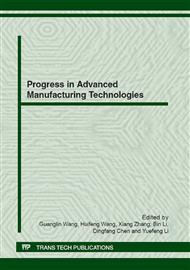p.36
p.41
p.47
p.52
p.58
p.62
p.68
p.72
p.76
Experimental Study on Pre-Stress Hard Cutting of Aero-Screw and its Machined Surface Residual Stress State
Abstract:
Pre-stress Hard Cutting, known as a new machining technology, is the combination of hard cutting and pre-stress cutting. Some reports show pre-stress machining can improve residual stress state of machined surface and prolong fatigue life of mechanical part, such as drive shaft, bearing and engine vane etc. Based on the principle of this technology, this paper take aero-screw shaft machining as object, investigated the pre-stress loading method, experimental device and implementation process of pre-stress hard cutting. Experiment is carried out for aero-screw shaft with PCBN tool, cutting force, machined surface residual stress state and distribution are measured. The experimental results show that by using this method, residual compressive stress is got on machined surface and good surface finish is gained, hence it can control machined surface residual stress state actively and improve the fatigue life of aero-screw shaft..
Info:
Periodical:
Pages:
58-61
Citation:
Online since:
August 2012
Authors:
Keywords:
Price:
Сopyright:
© 2012 Trans Tech Publications Ltd. All Rights Reserved
Share:
Citation:


